FIAC214 Report: Analysis of Qantas Airways Financial Performance
VerifiedAdded on 2022/11/25
|14
|2123
|490
Report
AI Summary
This report provides a comprehensive analysis of Qantas Airways' financial performance based on its annual report. It begins with an introduction to Qantas Airways, including its history and background. The report then identifies the most significant sections of the annual report, specifically the financial statements. It summarizes the Director's Report, highlighting key financial achievements and strategic decisions. The report also includes a summary of the Auditor's Report, including the auditor's opinion and key audit matters. A sales review is provided, followed by a cash flow analysis and an analysis of retained profit. The core of the report involves a detailed ratio analysis, covering profitability, liquidity, asset turnover, and leverage ratios, with tables and figures to illustrate the data. The analysis includes calculations and interpretations of each ratio, comparing the 2017 and 2018 financial years. The report concludes with an overall assessment of Qantas Airways' financial position, highlighting both strengths and weaknesses and referencing the sources used throughout the analysis.
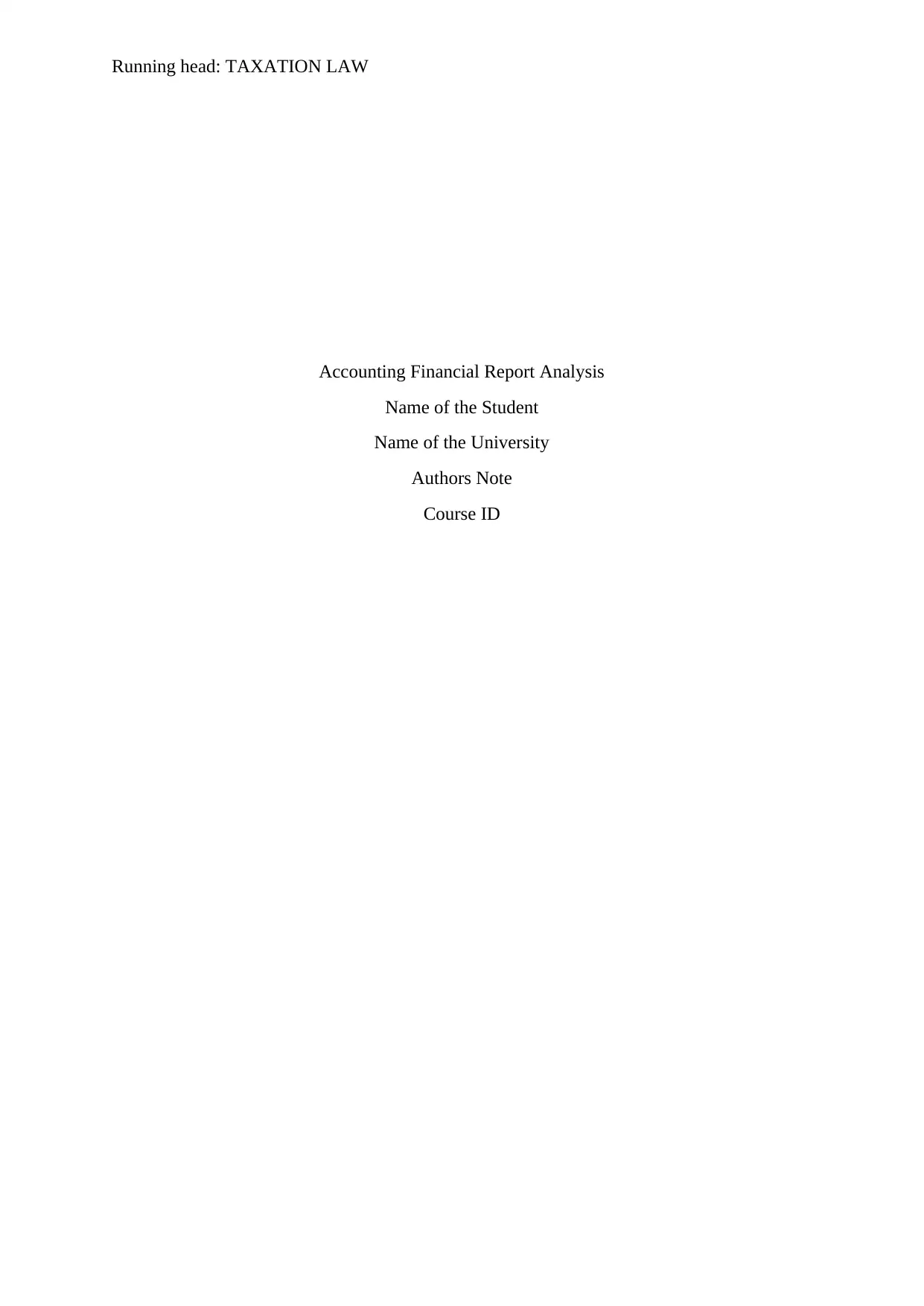
Running head: TAXATION LAW
Accounting Financial Report Analysis
Name of the Student
Name of the University
Authors Note
Course ID
Accounting Financial Report Analysis
Name of the Student
Name of the University
Authors Note
Course ID
Paraphrase This Document
Need a fresh take? Get an instant paraphrase of this document with our AI Paraphraser
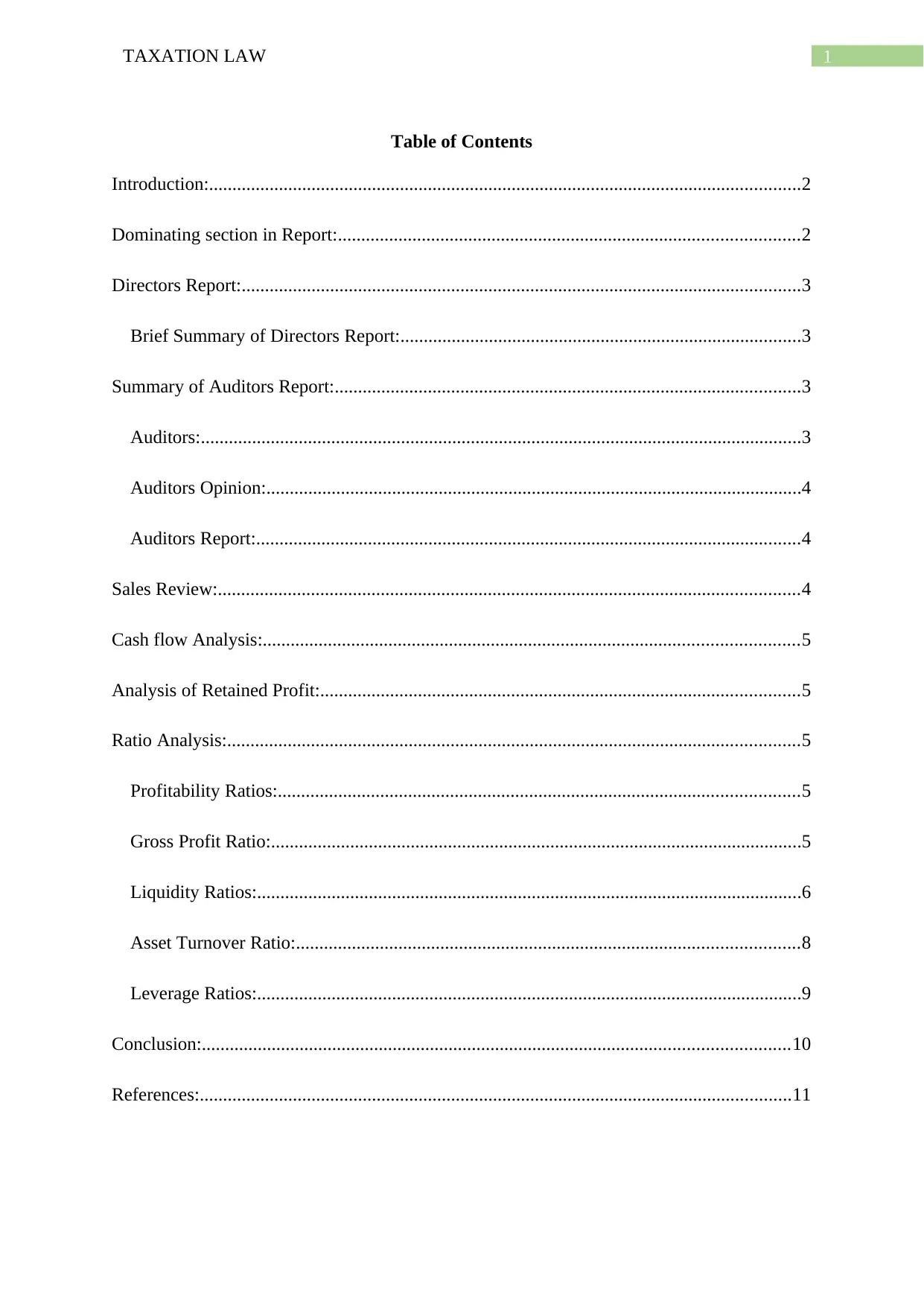
1TAXATION LAW
Table of Contents
Introduction:...............................................................................................................................2
Dominating section in Report:...................................................................................................2
Directors Report:........................................................................................................................3
Brief Summary of Directors Report:......................................................................................3
Summary of Auditors Report:....................................................................................................3
Auditors:.................................................................................................................................3
Auditors Opinion:...................................................................................................................4
Auditors Report:.....................................................................................................................4
Sales Review:.............................................................................................................................4
Cash flow Analysis:...................................................................................................................5
Analysis of Retained Profit:.......................................................................................................5
Ratio Analysis:...........................................................................................................................5
Profitability Ratios:................................................................................................................5
Gross Profit Ratio:..................................................................................................................5
Liquidity Ratios:.....................................................................................................................6
Asset Turnover Ratio:............................................................................................................8
Leverage Ratios:.....................................................................................................................9
Conclusion:..............................................................................................................................10
References:...............................................................................................................................11
Table of Contents
Introduction:...............................................................................................................................2
Dominating section in Report:...................................................................................................2
Directors Report:........................................................................................................................3
Brief Summary of Directors Report:......................................................................................3
Summary of Auditors Report:....................................................................................................3
Auditors:.................................................................................................................................3
Auditors Opinion:...................................................................................................................4
Auditors Report:.....................................................................................................................4
Sales Review:.............................................................................................................................4
Cash flow Analysis:...................................................................................................................5
Analysis of Retained Profit:.......................................................................................................5
Ratio Analysis:...........................................................................................................................5
Profitability Ratios:................................................................................................................5
Gross Profit Ratio:..................................................................................................................5
Liquidity Ratios:.....................................................................................................................6
Asset Turnover Ratio:............................................................................................................8
Leverage Ratios:.....................................................................................................................9
Conclusion:..............................................................................................................................10
References:...............................................................................................................................11

2TAXATION LAW
⊘ This is a preview!⊘
Do you want full access?
Subscribe today to unlock all pages.

Trusted by 1+ million students worldwide
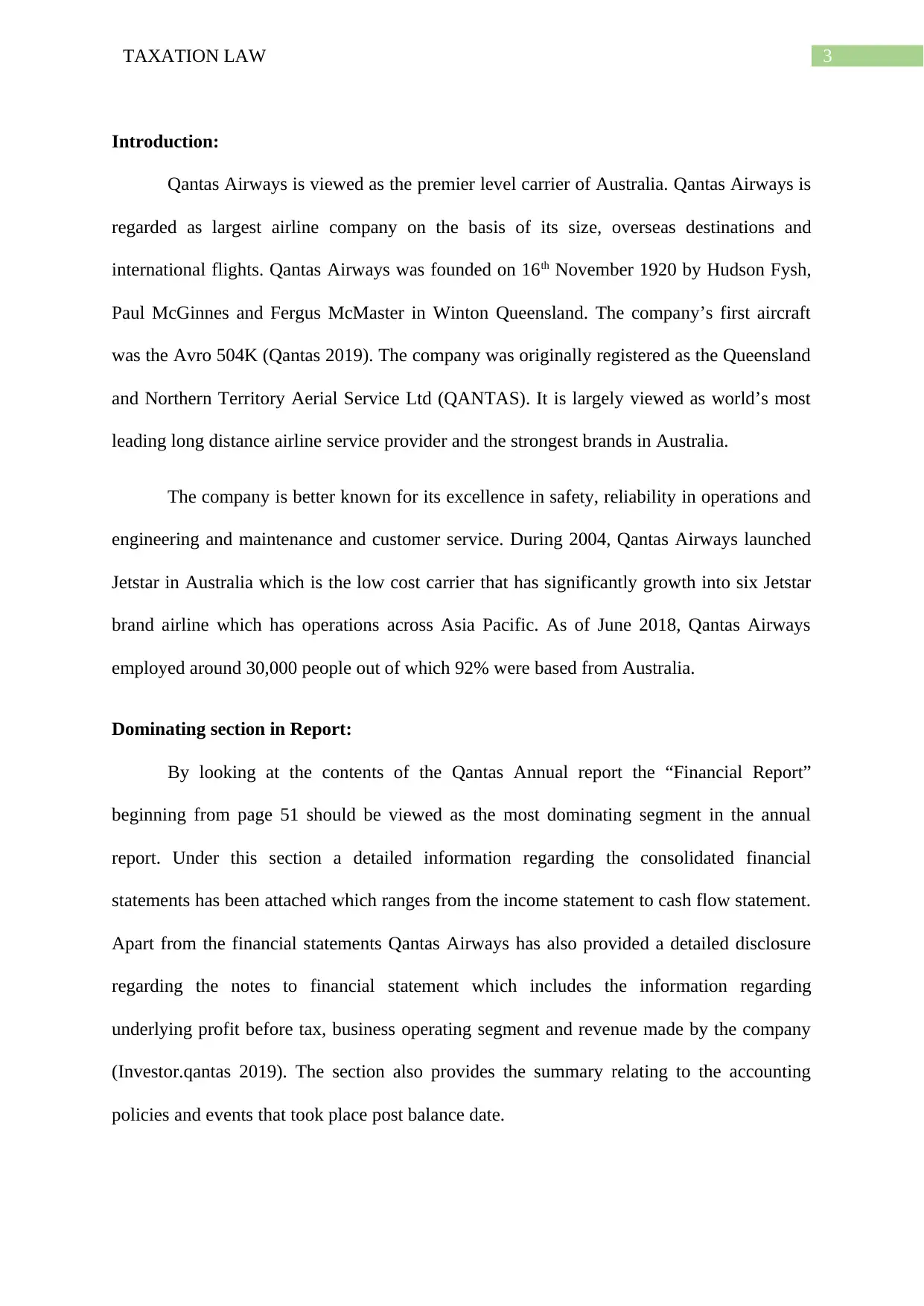
3TAXATION LAW
Introduction:
Qantas Airways is viewed as the premier level carrier of Australia. Qantas Airways is
regarded as largest airline company on the basis of its size, overseas destinations and
international flights. Qantas Airways was founded on 16th November 1920 by Hudson Fysh,
Paul McGinnes and Fergus McMaster in Winton Queensland. The company’s first aircraft
was the Avro 504K (Qantas 2019). The company was originally registered as the Queensland
and Northern Territory Aerial Service Ltd (QANTAS). It is largely viewed as world’s most
leading long distance airline service provider and the strongest brands in Australia.
The company is better known for its excellence in safety, reliability in operations and
engineering and maintenance and customer service. During 2004, Qantas Airways launched
Jetstar in Australia which is the low cost carrier that has significantly growth into six Jetstar
brand airline which has operations across Asia Pacific. As of June 2018, Qantas Airways
employed around 30,000 people out of which 92% were based from Australia.
Dominating section in Report:
By looking at the contents of the Qantas Annual report the “Financial Report”
beginning from page 51 should be viewed as the most dominating segment in the annual
report. Under this section a detailed information regarding the consolidated financial
statements has been attached which ranges from the income statement to cash flow statement.
Apart from the financial statements Qantas Airways has also provided a detailed disclosure
regarding the notes to financial statement which includes the information regarding
underlying profit before tax, business operating segment and revenue made by the company
(Investor.qantas 2019). The section also provides the summary relating to the accounting
policies and events that took place post balance date.
Introduction:
Qantas Airways is viewed as the premier level carrier of Australia. Qantas Airways is
regarded as largest airline company on the basis of its size, overseas destinations and
international flights. Qantas Airways was founded on 16th November 1920 by Hudson Fysh,
Paul McGinnes and Fergus McMaster in Winton Queensland. The company’s first aircraft
was the Avro 504K (Qantas 2019). The company was originally registered as the Queensland
and Northern Territory Aerial Service Ltd (QANTAS). It is largely viewed as world’s most
leading long distance airline service provider and the strongest brands in Australia.
The company is better known for its excellence in safety, reliability in operations and
engineering and maintenance and customer service. During 2004, Qantas Airways launched
Jetstar in Australia which is the low cost carrier that has significantly growth into six Jetstar
brand airline which has operations across Asia Pacific. As of June 2018, Qantas Airways
employed around 30,000 people out of which 92% were based from Australia.
Dominating section in Report:
By looking at the contents of the Qantas Annual report the “Financial Report”
beginning from page 51 should be viewed as the most dominating segment in the annual
report. Under this section a detailed information regarding the consolidated financial
statements has been attached which ranges from the income statement to cash flow statement.
Apart from the financial statements Qantas Airways has also provided a detailed disclosure
regarding the notes to financial statement which includes the information regarding
underlying profit before tax, business operating segment and revenue made by the company
(Investor.qantas 2019). The section also provides the summary relating to the accounting
policies and events that took place post balance date.
Paraphrase This Document
Need a fresh take? Get an instant paraphrase of this document with our AI Paraphraser
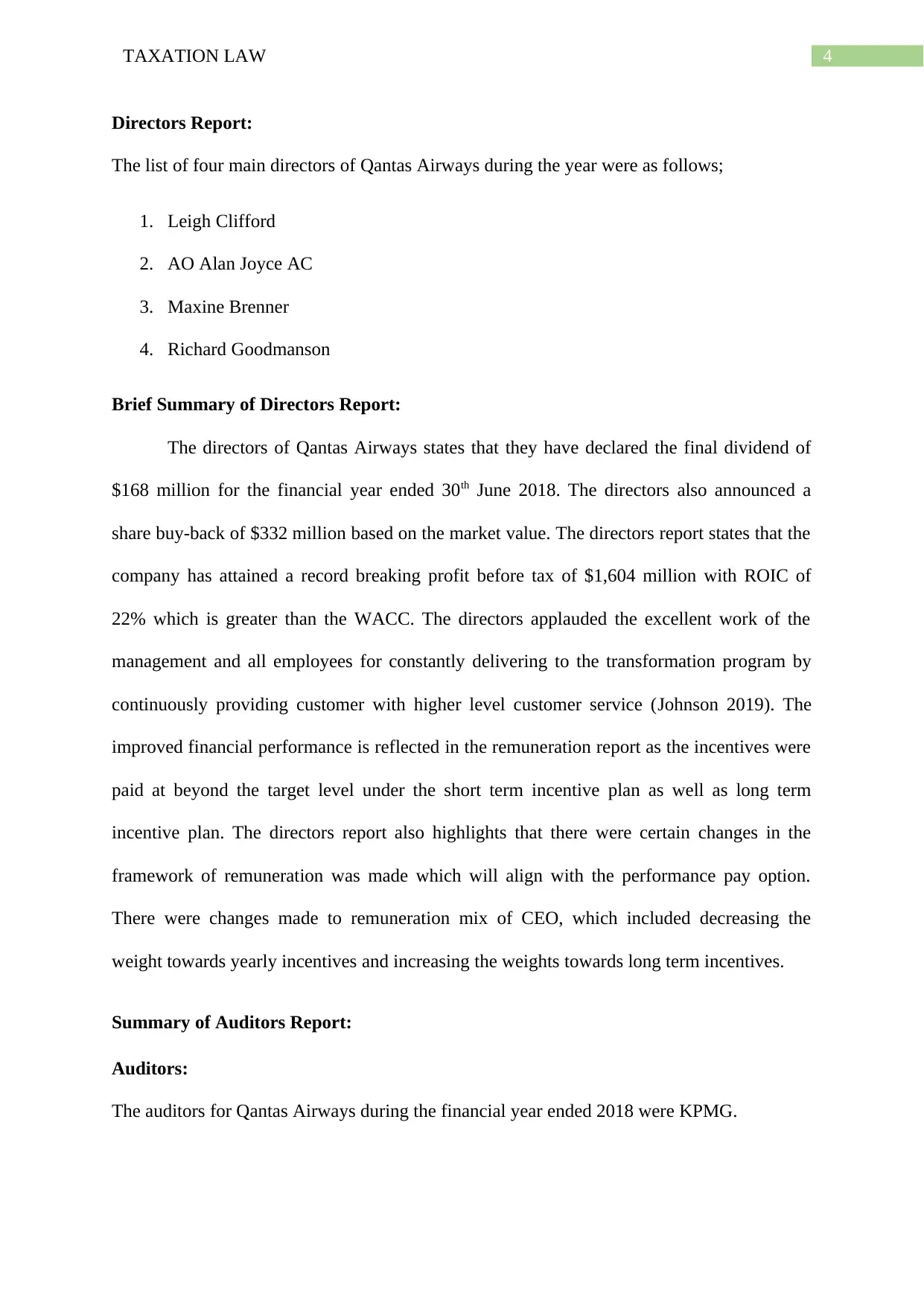
4TAXATION LAW
Directors Report:
The list of four main directors of Qantas Airways during the year were as follows;
1. Leigh Clifford
2. AO Alan Joyce AC
3. Maxine Brenner
4. Richard Goodmanson
Brief Summary of Directors Report:
The directors of Qantas Airways states that they have declared the final dividend of
$168 million for the financial year ended 30th June 2018. The directors also announced a
share buy-back of $332 million based on the market value. The directors report states that the
company has attained a record breaking profit before tax of $1,604 million with ROIC of
22% which is greater than the WACC. The directors applauded the excellent work of the
management and all employees for constantly delivering to the transformation program by
continuously providing customer with higher level customer service (Johnson 2019). The
improved financial performance is reflected in the remuneration report as the incentives were
paid at beyond the target level under the short term incentive plan as well as long term
incentive plan. The directors report also highlights that there were certain changes in the
framework of remuneration was made which will align with the performance pay option.
There were changes made to remuneration mix of CEO, which included decreasing the
weight towards yearly incentives and increasing the weights towards long term incentives.
Summary of Auditors Report:
Auditors:
The auditors for Qantas Airways during the financial year ended 2018 were KPMG.
Directors Report:
The list of four main directors of Qantas Airways during the year were as follows;
1. Leigh Clifford
2. AO Alan Joyce AC
3. Maxine Brenner
4. Richard Goodmanson
Brief Summary of Directors Report:
The directors of Qantas Airways states that they have declared the final dividend of
$168 million for the financial year ended 30th June 2018. The directors also announced a
share buy-back of $332 million based on the market value. The directors report states that the
company has attained a record breaking profit before tax of $1,604 million with ROIC of
22% which is greater than the WACC. The directors applauded the excellent work of the
management and all employees for constantly delivering to the transformation program by
continuously providing customer with higher level customer service (Johnson 2019). The
improved financial performance is reflected in the remuneration report as the incentives were
paid at beyond the target level under the short term incentive plan as well as long term
incentive plan. The directors report also highlights that there were certain changes in the
framework of remuneration was made which will align with the performance pay option.
There were changes made to remuneration mix of CEO, which included decreasing the
weight towards yearly incentives and increasing the weights towards long term incentives.
Summary of Auditors Report:
Auditors:
The auditors for Qantas Airways during the financial year ended 2018 were KPMG.
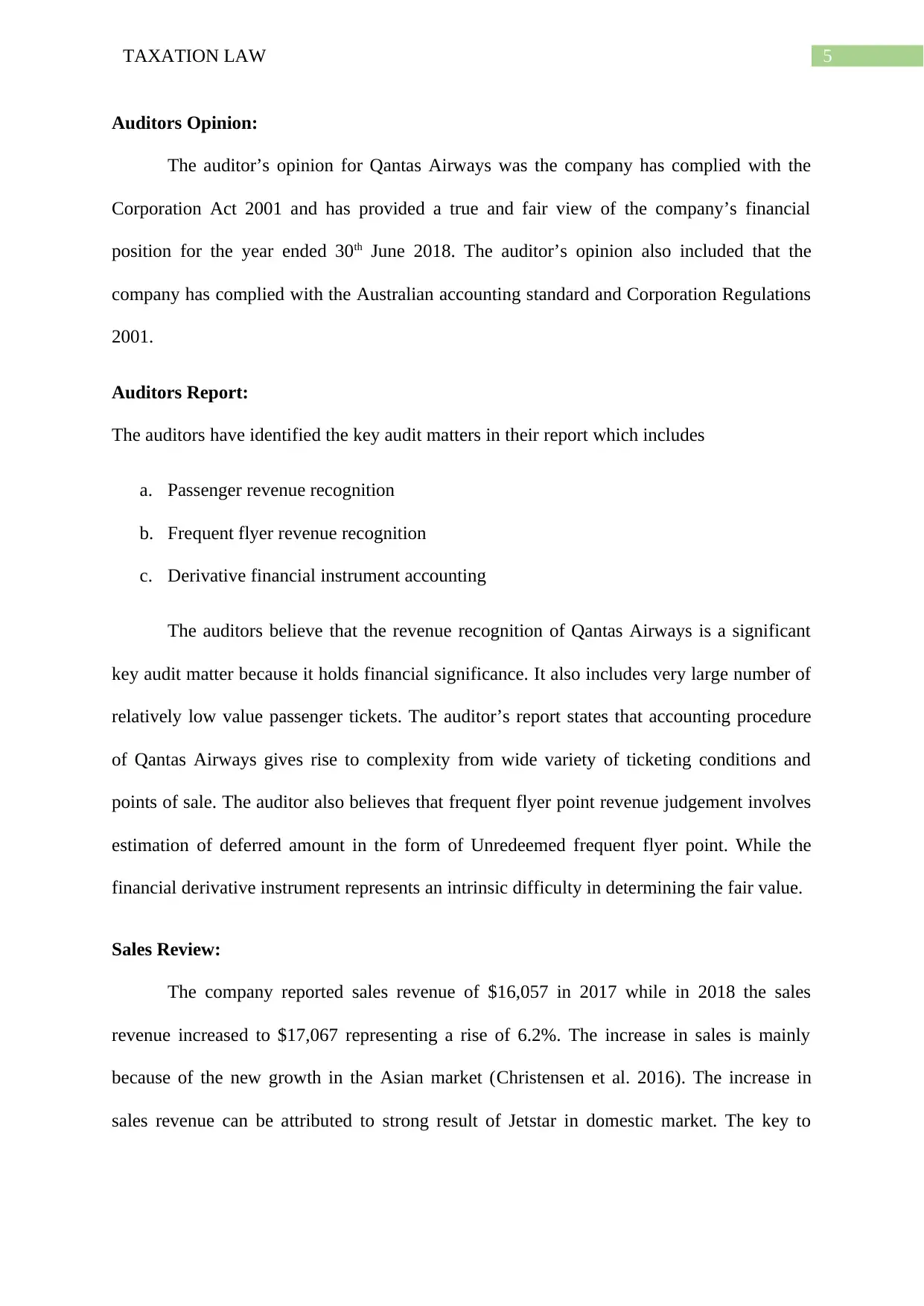
5TAXATION LAW
Auditors Opinion:
The auditor’s opinion for Qantas Airways was the company has complied with the
Corporation Act 2001 and has provided a true and fair view of the company’s financial
position for the year ended 30th June 2018. The auditor’s opinion also included that the
company has complied with the Australian accounting standard and Corporation Regulations
2001.
Auditors Report:
The auditors have identified the key audit matters in their report which includes
a. Passenger revenue recognition
b. Frequent flyer revenue recognition
c. Derivative financial instrument accounting
The auditors believe that the revenue recognition of Qantas Airways is a significant
key audit matter because it holds financial significance. It also includes very large number of
relatively low value passenger tickets. The auditor’s report states that accounting procedure
of Qantas Airways gives rise to complexity from wide variety of ticketing conditions and
points of sale. The auditor also believes that frequent flyer point revenue judgement involves
estimation of deferred amount in the form of Unredeemed frequent flyer point. While the
financial derivative instrument represents an intrinsic difficulty in determining the fair value.
Sales Review:
The company reported sales revenue of $16,057 in 2017 while in 2018 the sales
revenue increased to $17,067 representing a rise of 6.2%. The increase in sales is mainly
because of the new growth in the Asian market (Christensen et al. 2016). The increase in
sales revenue can be attributed to strong result of Jetstar in domestic market. The key to
Auditors Opinion:
The auditor’s opinion for Qantas Airways was the company has complied with the
Corporation Act 2001 and has provided a true and fair view of the company’s financial
position for the year ended 30th June 2018. The auditor’s opinion also included that the
company has complied with the Australian accounting standard and Corporation Regulations
2001.
Auditors Report:
The auditors have identified the key audit matters in their report which includes
a. Passenger revenue recognition
b. Frequent flyer revenue recognition
c. Derivative financial instrument accounting
The auditors believe that the revenue recognition of Qantas Airways is a significant
key audit matter because it holds financial significance. It also includes very large number of
relatively low value passenger tickets. The auditor’s report states that accounting procedure
of Qantas Airways gives rise to complexity from wide variety of ticketing conditions and
points of sale. The auditor also believes that frequent flyer point revenue judgement involves
estimation of deferred amount in the form of Unredeemed frequent flyer point. While the
financial derivative instrument represents an intrinsic difficulty in determining the fair value.
Sales Review:
The company reported sales revenue of $16,057 in 2017 while in 2018 the sales
revenue increased to $17,067 representing a rise of 6.2%. The increase in sales is mainly
because of the new growth in the Asian market (Christensen et al. 2016). The increase in
sales revenue can be attributed to strong result of Jetstar in domestic market. The key to
⊘ This is a preview!⊘
Do you want full access?
Subscribe today to unlock all pages.

Trusted by 1+ million students worldwide
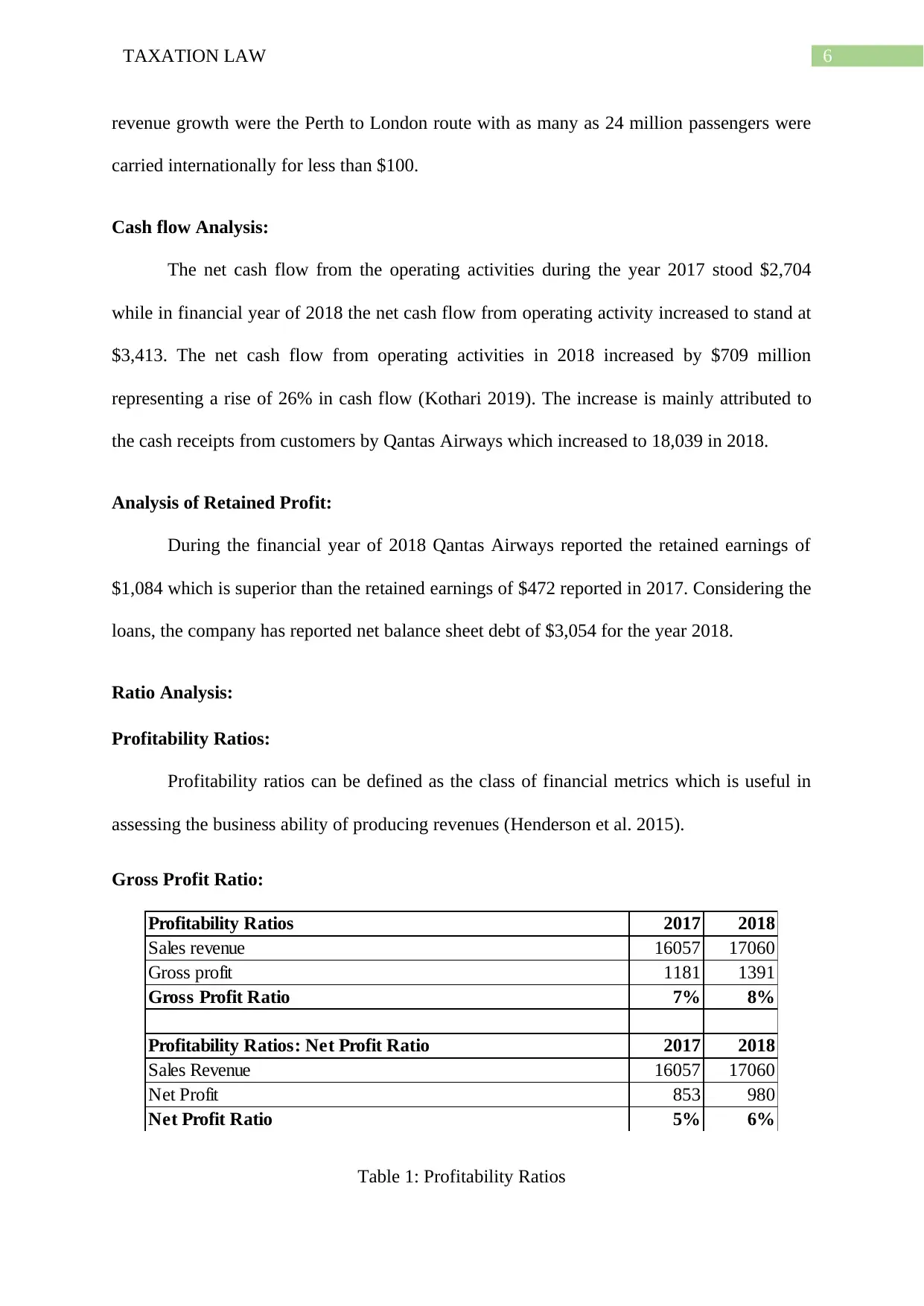
6TAXATION LAW
revenue growth were the Perth to London route with as many as 24 million passengers were
carried internationally for less than $100.
Cash flow Analysis:
The net cash flow from the operating activities during the year 2017 stood $2,704
while in financial year of 2018 the net cash flow from operating activity increased to stand at
$3,413. The net cash flow from operating activities in 2018 increased by $709 million
representing a rise of 26% in cash flow (Kothari 2019). The increase is mainly attributed to
the cash receipts from customers by Qantas Airways which increased to 18,039 in 2018.
Analysis of Retained Profit:
During the financial year of 2018 Qantas Airways reported the retained earnings of
$1,084 which is superior than the retained earnings of $472 reported in 2017. Considering the
loans, the company has reported net balance sheet debt of $3,054 for the year 2018.
Ratio Analysis:
Profitability Ratios:
Profitability ratios can be defined as the class of financial metrics which is useful in
assessing the business ability of producing revenues (Henderson et al. 2015).
Gross Profit Ratio:
Profitability Ratios 2017 2018
Sales revenue 16057 17060
Gross profit 1181 1391
Gross Profit Ratio 7% 8%
Profitability Ratios: Net Profit Ratio 2017 2018
Sales Revenue 16057 17060
Net Profit 853 980
Net Profit Ratio 5% 6%
Table 1: Profitability Ratios
revenue growth were the Perth to London route with as many as 24 million passengers were
carried internationally for less than $100.
Cash flow Analysis:
The net cash flow from the operating activities during the year 2017 stood $2,704
while in financial year of 2018 the net cash flow from operating activity increased to stand at
$3,413. The net cash flow from operating activities in 2018 increased by $709 million
representing a rise of 26% in cash flow (Kothari 2019). The increase is mainly attributed to
the cash receipts from customers by Qantas Airways which increased to 18,039 in 2018.
Analysis of Retained Profit:
During the financial year of 2018 Qantas Airways reported the retained earnings of
$1,084 which is superior than the retained earnings of $472 reported in 2017. Considering the
loans, the company has reported net balance sheet debt of $3,054 for the year 2018.
Ratio Analysis:
Profitability Ratios:
Profitability ratios can be defined as the class of financial metrics which is useful in
assessing the business ability of producing revenues (Henderson et al. 2015).
Gross Profit Ratio:
Profitability Ratios 2017 2018
Sales revenue 16057 17060
Gross profit 1181 1391
Gross Profit Ratio 7% 8%
Profitability Ratios: Net Profit Ratio 2017 2018
Sales Revenue 16057 17060
Net Profit 853 980
Net Profit Ratio 5% 6%
Table 1: Profitability Ratios
Paraphrase This Document
Need a fresh take? Get an instant paraphrase of this document with our AI Paraphraser
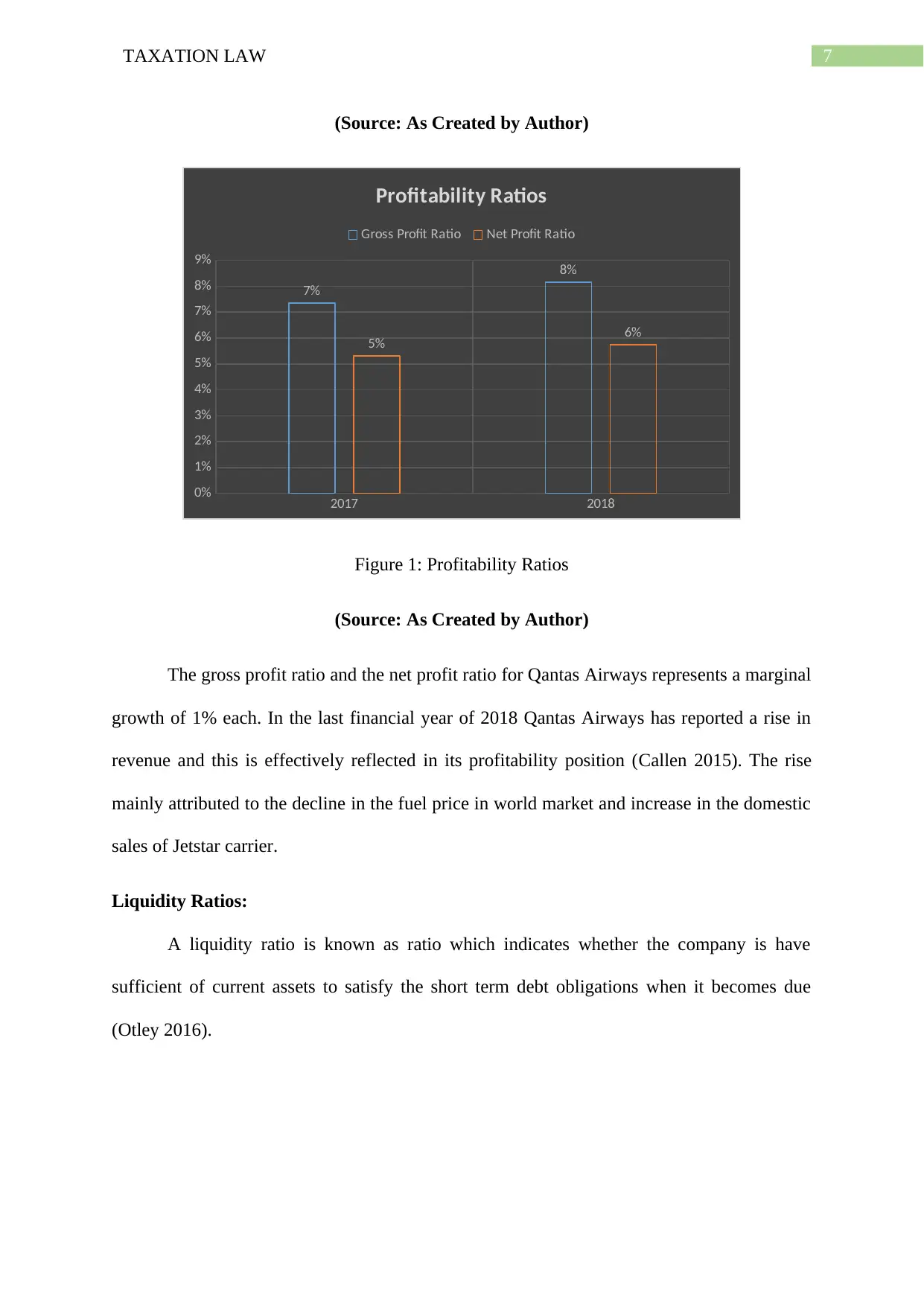
7TAXATION LAW
(Source: As Created by Author)
2017 2018
0%
1%
2%
3%
4%
5%
6%
7%
8%
9%
7%
8%
5% 6%
Profitability Ratios
Gross Profit Ratio Net Profit Ratio
Figure 1: Profitability Ratios
(Source: As Created by Author)
The gross profit ratio and the net profit ratio for Qantas Airways represents a marginal
growth of 1% each. In the last financial year of 2018 Qantas Airways has reported a rise in
revenue and this is effectively reflected in its profitability position (Callen 2015). The rise
mainly attributed to the decline in the fuel price in world market and increase in the domestic
sales of Jetstar carrier.
Liquidity Ratios:
A liquidity ratio is known as ratio which indicates whether the company is have
sufficient of current assets to satisfy the short term debt obligations when it becomes due
(Otley 2016).
(Source: As Created by Author)
2017 2018
0%
1%
2%
3%
4%
5%
6%
7%
8%
9%
7%
8%
5% 6%
Profitability Ratios
Gross Profit Ratio Net Profit Ratio
Figure 1: Profitability Ratios
(Source: As Created by Author)
The gross profit ratio and the net profit ratio for Qantas Airways represents a marginal
growth of 1% each. In the last financial year of 2018 Qantas Airways has reported a rise in
revenue and this is effectively reflected in its profitability position (Callen 2015). The rise
mainly attributed to the decline in the fuel price in world market and increase in the domestic
sales of Jetstar carrier.
Liquidity Ratios:
A liquidity ratio is known as ratio which indicates whether the company is have
sufficient of current assets to satisfy the short term debt obligations when it becomes due
(Otley 2016).
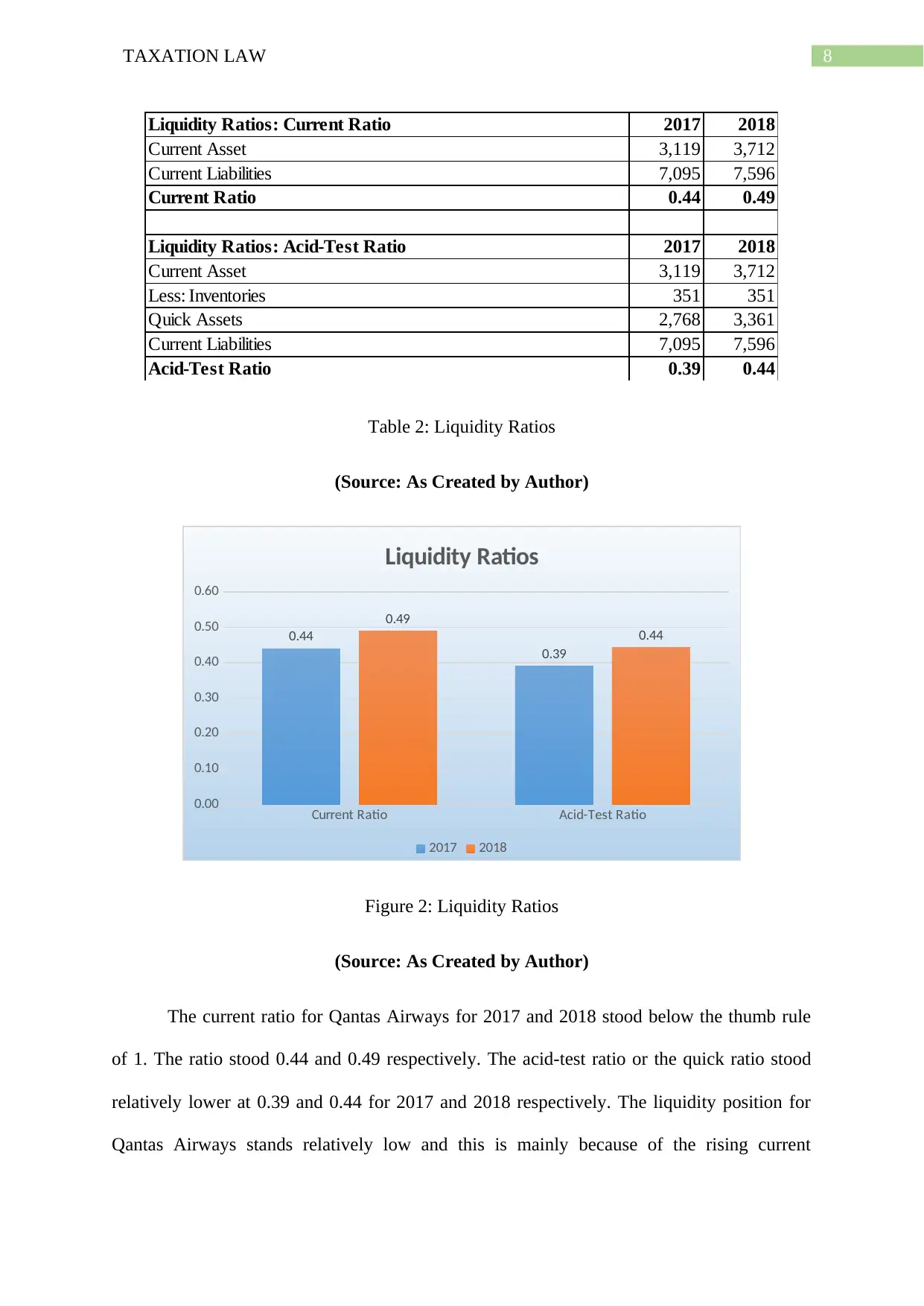
8TAXATION LAW
Liquidity Ratios: Current Ratio 2017 2018
Current Asset 3,119 3,712
Current Liabilities 7,095 7,596
Current Ratio 0.44 0.49
Liquidity Ratios: Acid-Test Ratio 2017 2018
Current Asset 3,119 3,712
Less: Inventories 351 351
Quick Assets 2,768 3,361
Current Liabilities 7,095 7,596
Acid-Test Ratio 0.39 0.44
Table 2: Liquidity Ratios
(Source: As Created by Author)
Current Ratio Acid-Test Ratio
0.00
0.10
0.20
0.30
0.40
0.50
0.60
0.44
0.39
0.49
0.44
Liquidity Ratios
2017 2018
Figure 2: Liquidity Ratios
(Source: As Created by Author)
The current ratio for Qantas Airways for 2017 and 2018 stood below the thumb rule
of 1. The ratio stood 0.44 and 0.49 respectively. The acid-test ratio or the quick ratio stood
relatively lower at 0.39 and 0.44 for 2017 and 2018 respectively. The liquidity position for
Qantas Airways stands relatively low and this is mainly because of the rising current
Liquidity Ratios: Current Ratio 2017 2018
Current Asset 3,119 3,712
Current Liabilities 7,095 7,596
Current Ratio 0.44 0.49
Liquidity Ratios: Acid-Test Ratio 2017 2018
Current Asset 3,119 3,712
Less: Inventories 351 351
Quick Assets 2,768 3,361
Current Liabilities 7,095 7,596
Acid-Test Ratio 0.39 0.44
Table 2: Liquidity Ratios
(Source: As Created by Author)
Current Ratio Acid-Test Ratio
0.00
0.10
0.20
0.30
0.40
0.50
0.60
0.44
0.39
0.49
0.44
Liquidity Ratios
2017 2018
Figure 2: Liquidity Ratios
(Source: As Created by Author)
The current ratio for Qantas Airways for 2017 and 2018 stood below the thumb rule
of 1. The ratio stood 0.44 and 0.49 respectively. The acid-test ratio or the quick ratio stood
relatively lower at 0.39 and 0.44 for 2017 and 2018 respectively. The liquidity position for
Qantas Airways stands relatively low and this is mainly because of the rising current
⊘ This is a preview!⊘
Do you want full access?
Subscribe today to unlock all pages.

Trusted by 1+ million students worldwide
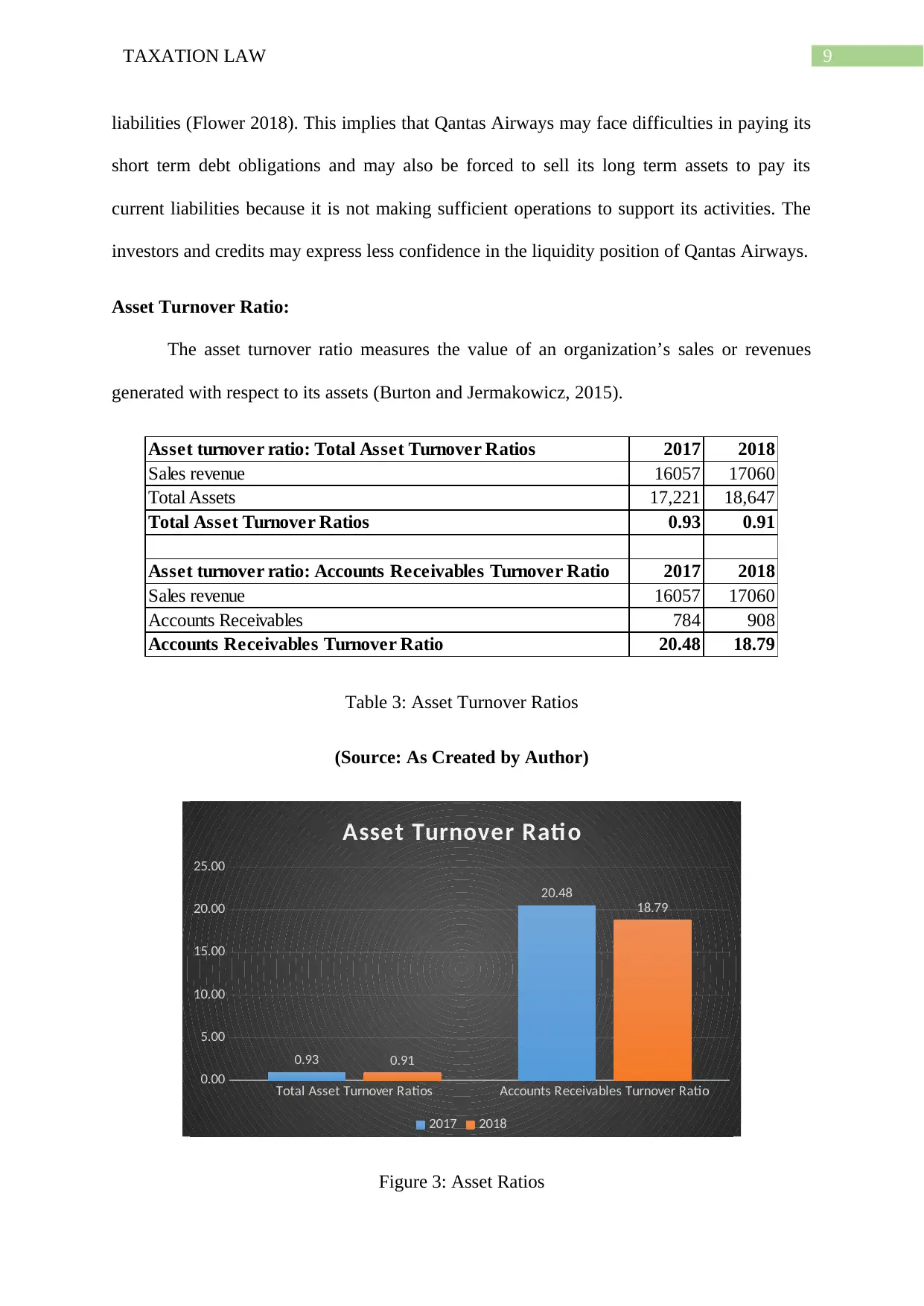
9TAXATION LAW
liabilities (Flower 2018). This implies that Qantas Airways may face difficulties in paying its
short term debt obligations and may also be forced to sell its long term assets to pay its
current liabilities because it is not making sufficient operations to support its activities. The
investors and credits may express less confidence in the liquidity position of Qantas Airways.
Asset Turnover Ratio:
The asset turnover ratio measures the value of an organization’s sales or revenues
generated with respect to its assets (Burton and Jermakowicz, 2015).
Asset turnover ratio: Total Asset Turnover Ratios 2017 2018
Sales revenue 16057 17060
Total Assets 17,221 18,647
Total Asset Turnover Ratios 0.93 0.91
Asset turnover ratio: Accounts Receivables Turnover Ratio 2017 2018
Sales revenue 16057 17060
Accounts Receivables 784 908
Accounts Receivables Turnover Ratio 20.48 18.79
Table 3: Asset Turnover Ratios
(Source: As Created by Author)
Total Asset Turnover Ratios Accounts Receivables Turnover Ratio
0.00
5.00
10.00
15.00
20.00
25.00
0.93
20.48
0.91
18.79
Asset Turnover Ratio
2017 2018
Figure 3: Asset Ratios
liabilities (Flower 2018). This implies that Qantas Airways may face difficulties in paying its
short term debt obligations and may also be forced to sell its long term assets to pay its
current liabilities because it is not making sufficient operations to support its activities. The
investors and credits may express less confidence in the liquidity position of Qantas Airways.
Asset Turnover Ratio:
The asset turnover ratio measures the value of an organization’s sales or revenues
generated with respect to its assets (Burton and Jermakowicz, 2015).
Asset turnover ratio: Total Asset Turnover Ratios 2017 2018
Sales revenue 16057 17060
Total Assets 17,221 18,647
Total Asset Turnover Ratios 0.93 0.91
Asset turnover ratio: Accounts Receivables Turnover Ratio 2017 2018
Sales revenue 16057 17060
Accounts Receivables 784 908
Accounts Receivables Turnover Ratio 20.48 18.79
Table 3: Asset Turnover Ratios
(Source: As Created by Author)
Total Asset Turnover Ratios Accounts Receivables Turnover Ratio
0.00
5.00
10.00
15.00
20.00
25.00
0.93
20.48
0.91
18.79
Asset Turnover Ratio
2017 2018
Figure 3: Asset Ratios
Paraphrase This Document
Need a fresh take? Get an instant paraphrase of this document with our AI Paraphraser
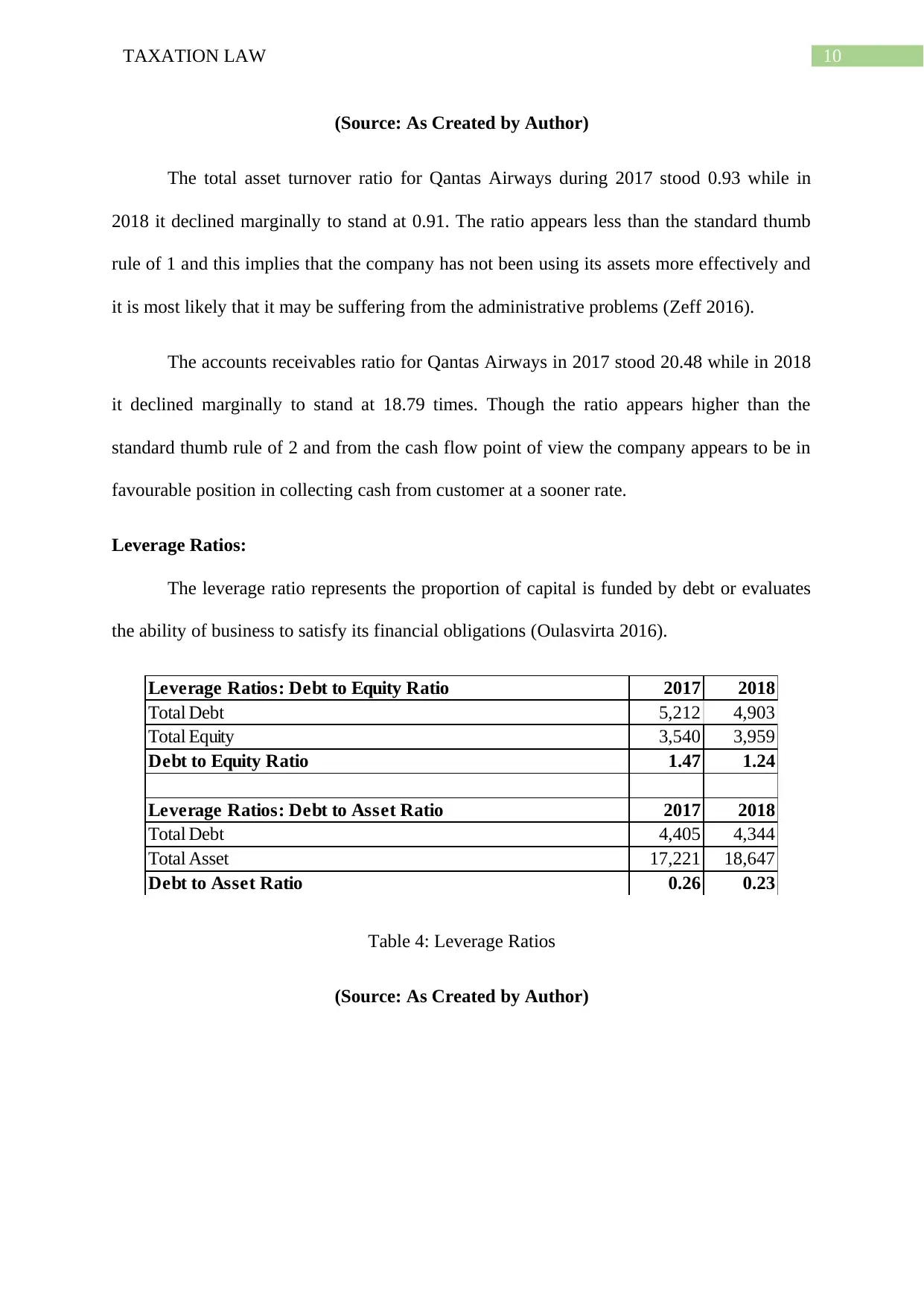
10TAXATION LAW
(Source: As Created by Author)
The total asset turnover ratio for Qantas Airways during 2017 stood 0.93 while in
2018 it declined marginally to stand at 0.91. The ratio appears less than the standard thumb
rule of 1 and this implies that the company has not been using its assets more effectively and
it is most likely that it may be suffering from the administrative problems (Zeff 2016).
The accounts receivables ratio for Qantas Airways in 2017 stood 20.48 while in 2018
it declined marginally to stand at 18.79 times. Though the ratio appears higher than the
standard thumb rule of 2 and from the cash flow point of view the company appears to be in
favourable position in collecting cash from customer at a sooner rate.
Leverage Ratios:
The leverage ratio represents the proportion of capital is funded by debt or evaluates
the ability of business to satisfy its financial obligations (Oulasvirta 2016).
Leverage Ratios: Debt to Equity Ratio 2017 2018
Total Debt 5,212 4,903
Total Equity 3,540 3,959
Debt to Equity Ratio 1.47 1.24
Leverage Ratios: Debt to Asset Ratio 2017 2018
Total Debt 4,405 4,344
Total Asset 17,221 18,647
Debt to Asset Ratio 0.26 0.23
Table 4: Leverage Ratios
(Source: As Created by Author)
(Source: As Created by Author)
The total asset turnover ratio for Qantas Airways during 2017 stood 0.93 while in
2018 it declined marginally to stand at 0.91. The ratio appears less than the standard thumb
rule of 1 and this implies that the company has not been using its assets more effectively and
it is most likely that it may be suffering from the administrative problems (Zeff 2016).
The accounts receivables ratio for Qantas Airways in 2017 stood 20.48 while in 2018
it declined marginally to stand at 18.79 times. Though the ratio appears higher than the
standard thumb rule of 2 and from the cash flow point of view the company appears to be in
favourable position in collecting cash from customer at a sooner rate.
Leverage Ratios:
The leverage ratio represents the proportion of capital is funded by debt or evaluates
the ability of business to satisfy its financial obligations (Oulasvirta 2016).
Leverage Ratios: Debt to Equity Ratio 2017 2018
Total Debt 5,212 4,903
Total Equity 3,540 3,959
Debt to Equity Ratio 1.47 1.24
Leverage Ratios: Debt to Asset Ratio 2017 2018
Total Debt 4,405 4,344
Total Asset 17,221 18,647
Debt to Asset Ratio 0.26 0.23
Table 4: Leverage Ratios
(Source: As Created by Author)
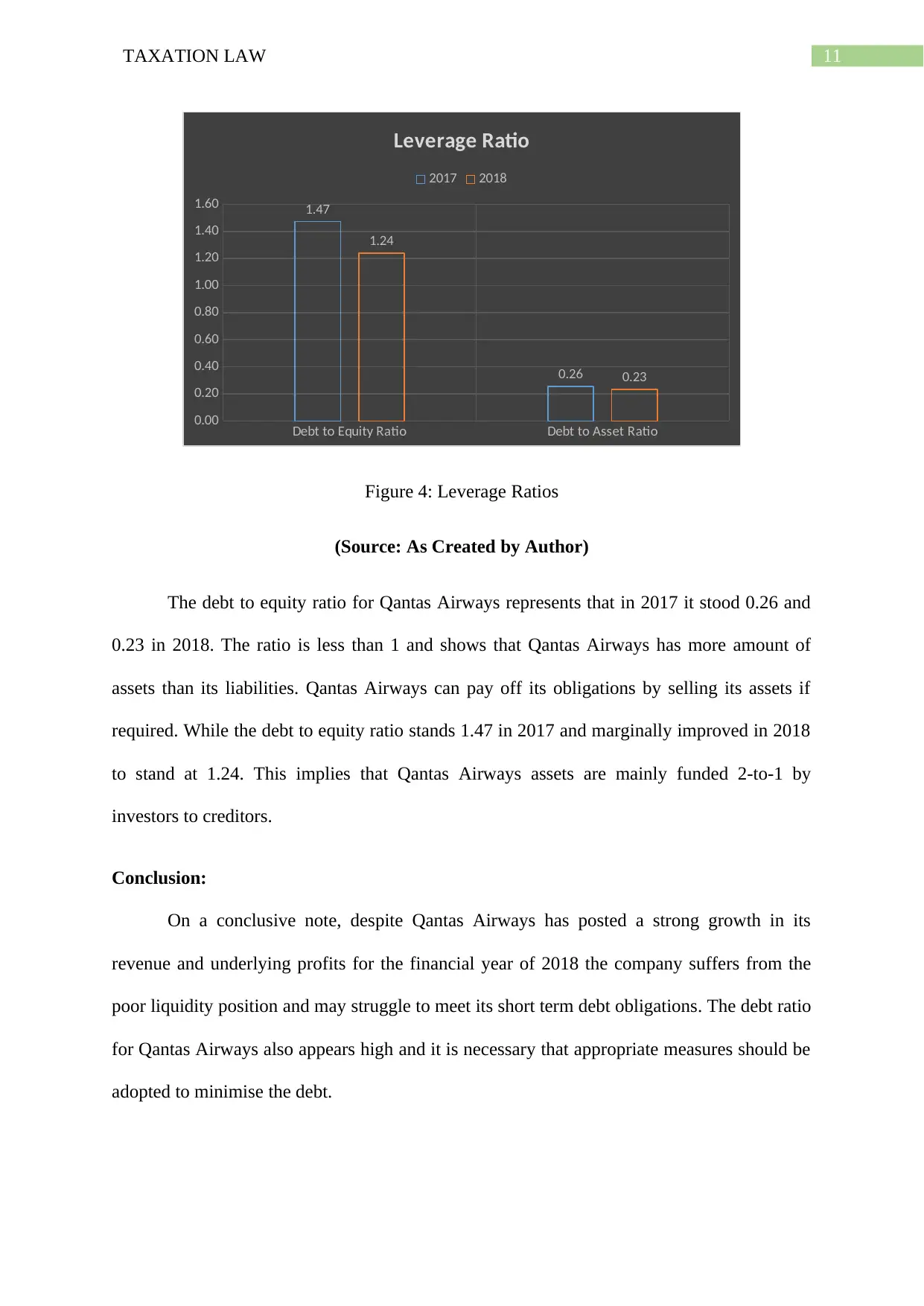
11TAXATION LAW
Debt to Equity Ratio Debt to Asset Ratio
0.00
0.20
0.40
0.60
0.80
1.00
1.20
1.40
1.60 1.47
0.26
1.24
0.23
Leverage Ratio
2017 2018
Figure 4: Leverage Ratios
(Source: As Created by Author)
The debt to equity ratio for Qantas Airways represents that in 2017 it stood 0.26 and
0.23 in 2018. The ratio is less than 1 and shows that Qantas Airways has more amount of
assets than its liabilities. Qantas Airways can pay off its obligations by selling its assets if
required. While the debt to equity ratio stands 1.47 in 2017 and marginally improved in 2018
to stand at 1.24. This implies that Qantas Airways assets are mainly funded 2-to-1 by
investors to creditors.
Conclusion:
On a conclusive note, despite Qantas Airways has posted a strong growth in its
revenue and underlying profits for the financial year of 2018 the company suffers from the
poor liquidity position and may struggle to meet its short term debt obligations. The debt ratio
for Qantas Airways also appears high and it is necessary that appropriate measures should be
adopted to minimise the debt.
Debt to Equity Ratio Debt to Asset Ratio
0.00
0.20
0.40
0.60
0.80
1.00
1.20
1.40
1.60 1.47
0.26
1.24
0.23
Leverage Ratio
2017 2018
Figure 4: Leverage Ratios
(Source: As Created by Author)
The debt to equity ratio for Qantas Airways represents that in 2017 it stood 0.26 and
0.23 in 2018. The ratio is less than 1 and shows that Qantas Airways has more amount of
assets than its liabilities. Qantas Airways can pay off its obligations by selling its assets if
required. While the debt to equity ratio stands 1.47 in 2017 and marginally improved in 2018
to stand at 1.24. This implies that Qantas Airways assets are mainly funded 2-to-1 by
investors to creditors.
Conclusion:
On a conclusive note, despite Qantas Airways has posted a strong growth in its
revenue and underlying profits for the financial year of 2018 the company suffers from the
poor liquidity position and may struggle to meet its short term debt obligations. The debt ratio
for Qantas Airways also appears high and it is necessary that appropriate measures should be
adopted to minimise the debt.
⊘ This is a preview!⊘
Do you want full access?
Subscribe today to unlock all pages.

Trusted by 1+ million students worldwide
1 out of 14
Related Documents
Your All-in-One AI-Powered Toolkit for Academic Success.
+13062052269
info@desklib.com
Available 24*7 on WhatsApp / Email
![[object Object]](/_next/static/media/star-bottom.7253800d.svg)
Unlock your academic potential
Copyright © 2020–2026 A2Z Services. All Rights Reserved. Developed and managed by ZUCOL.




